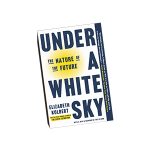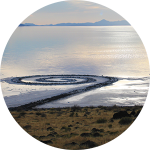Week 4: Look Up
Hello, and welcome to the final installment of our 4-week exploration of Under a White Sky. Catch up on weeks 1, 2, and 3 if you haven’t yet. On May 21, we’ll be hosting Elizabeth Kolbert in conversation with Ezra Klein at the UCSC Quarry Amphitheater. And on June 7, we’ll be hosting a Community Salon at the Seymour Marine Discovery Center in Santa Cruz focused on actions you can take in the face of the climate catastrophe Kolbert depicts.
This week, we look up at the sky from our position and perspective on this planet. We’ll talk with UCSC professor of Environmental Studies Sikina Jinnah about the research and governance surrounding the white sky of the book’s title. We’ll also see the earth and Kolbert’s narrative through the artistic lens of UCSC professor of Environmental Art, Jorge Menna Barreto.
Let’s dig in!

White Sky
Sikina Jinnah has spent a lot of time thinking about the possibilities and consequences of solar geoengineering, which could have the impact of turning our blue sky white. Her work has put her at the table with many of the figures featured in Kolbert’s book, and she has wrestled with the issues they and Kolbert raise around solar geoengineering technology, particularly as related to international politics and global oversight.
Deep Read: Tell us about your career and your work.

Sikina Jinnah: I am an interdisciplinary social scientist, primarily in the fields of political science and global governance as it relates to the environment. I think a lot about how countries cooperate internationally to address environmental problems, so most of my work for most of my career has focused on climate change and international collaboration. For nearly a decade now, I’ve been working on the governance of solar geoengineering, which is the phenomenon for which Under a White Sky is named.
What is solar geoengineering?
There’s a growing body of research emerging alongside political discussions on solar geoengineering. In particular, solar geoengineering is stratospheric aerosol injection, which is what Kolbert is talking about in her book. It’s a set of emerging technologies that would deposit reflective aerosols in the stratosphere to reflect solar radiation in order to stave off some of the worst climate impacts for a short period of time. It’s a short-term, emergency response measure that could possibly be used to ameliorate some of the most intense climate impacts for the world’s most vulnerable populations that would give us time to get far more aggressive about greenhouse gas reductions and scale up carbon removal. While that research is evolving quickly, the governance landscape is pretty vacant.
In fact, there’s really almost no governance out there. A lot of my work thinks about how we bring theories of global governance to bear on the research of solar geoengineering so that there are structures in place to minimize potential negative impacts of research in this area. We need basic things like research transparency and public funding mechanisms for this as opposed to the current situation in which so much of the research is pushed into the private sector, which means we really have no idea what’s actually happening. For instance, there aren’t requirements for making data public or making transparent the types of projects that are funded.
What’s important to know about the solar geoengineering conversations you’re having?
Broadly speaking, there are two camps of debate on solar geoengineering. On the one hand, you have people like David Keith, who Kolbert interviews, and is very positive about moving research forward. He has advocated that solar geoengineering is a justice-oriented response to some of the most horrific impacts of climate change, which are going to affect the world’s most vulnerable. For him, and others who share this perspective, solar geoengineering might be a way to ameliorate some of those impacts that are going to happen, regardless of what we do today or tomorrow, in terms of emission reductions.
On the other hand, there are scholars who strongly advocate against solar geoengineering, including what effectively amounts to a ban on research. They argue that it is fundamentally unjust in part because the Global South has not been adequately involved in science, discussions, or decisions around solar geoengineering research. This is true and also some of the governance proposals coming out of this camp are quite scary and even reckless. They want to ban public funding and international assessment, including in the Intergovernmental Panel on Climate Change (IPCC).
My own perspective is that we can and must govern research on solar geoengineering and that IPCC assessment is critical to ensuring scientifically informed decision making, whether that be to move research forward or to shut it down if the risks are found to be too great.
I co-chair the Stratospheric Controlled Perturbation Experiment (SCoPEx) Advisory Committee and our job is to provide a recommendation to Harvard’s Vice Provost for Research on if and under what conditions that small-scale, outdoor solar geoengineering experiment could proceed. If it does, it would be the first of its kind. We’ve developed a robust governance structure for evaluation of outdoor experimentation that includes financial, technical, scientific, and societal reviews. Our hope is that we are developing a model that can be used for evaluating other proposed outdoor experiments to ensure effective, responsible, and just research on solar geoengineering.
What can people do in the face of the large and complicated problem of climate change?
I often assign an article in my undergraduate course, ENVS 25: Environmental Policy, Economics, and Justice, entitled, “Individualization: Plant a Tree, Buy a Bike, Save the World?” by Michael F. Maniates. The basic argument is that individual action doesn’t matter a whole lot and that to solve the types of problems that we’re currently grappling with we must work through institutions. In short, collective action matters more than individual action. While individual actions can make people feel good, many are not really about substantive change and might in fact give people a sense of complacency about the need for action. I think there’s a lot of room for collective action to yield institutional change that can move the needle on this topic. Is there room for that to happen before a whole lot of suffering? No. Is there room for that before a whole lot more suffering? Yes. So there’s definitely space to make the world better. But, unfortunately, I think we’re going to experience quite a lot of trauma before we get there.
Go deep: What do you think about the “justice discourse” around solar geoengineering? Why would it be important for researchers and governments to include the Global South in their decision making? What’s your response to the idea that there’s a limit to what individual action can do? What kind of collective action should we be taking? Do you feel, like Professor Jinnah, that suffering is inevitable? Overall, what do you think about the various solar geoengineering projects described in Under a White Sky? Do you think living under a white sky is a manageable consequence?
Seeing Sculpture
Jorge Menna Barreto is an artist and educator whose practice and research have been dedicated to site-specific art for over 20 years. Since 2014, he has investigated possible relations between site-specificity and agroecology, with a focus on agroforestry. He teaches in the new MFA program in Environmental Art and Social Practice here at UC Santa Cruz.
Deep Read: Tell us about your work and research?

Jorge Menna Barreto: Since I finished art school, I’ve been interested in site specificity. I like to quote the artist Robert Smithson to define site specificity. When he was building his most famous work, “Spiral Jetty” (left) in 1970, he wrote, “I was still not sure what shape my work of art would take. I thought of making an island with the help of boats and barges, but in the end I would let the site determine what I would build.” Before the “but” in the last sentence, there’s a comma, and that comma is really telling of how revolutionary that moment is. Before the comma, you have the artist coming onto the site with an idea about what he will install into the place, so the place is assumed as neutral and receptive to the artistic gesture. After the comma, he is giving up on his initial idea, which I think is the most sculptural aspect of “Spiral Jetty,” namely the renunciation of an artistic idea that was coming from the artist’s head; in giving that up, he opened up space to let the site determine what he would build. What he’s saying here is that it’s not about me, the artist, anymore, but the site that exists before me; it will dictate what I will build. So I’m engaging in a relationship with the site that is collaborative and that is not dictatorial. That is site specificity.
Of course this is in 1970, and Smithson was speaking about a site that is quite literal and concrete. Since then, artists have been engaging with communities, different contexts, and different layers of a site that are the historical layers, the economic layers. So that quote has gained a lot more complexity, and it does result in what today we call environmental art and social practice, which is our newly launched MFA here at UC Santa Cruz.
How do you connect your art and research to Kolbert’s book?
One point of research contact with Under a White Sky is related to what I call the sculpturability of the planet. As I read through the book, I understood that Kolbert was describing how certain humans have been shaping entire ecosystems, leaving a mark that creates a new geological era. In my research as an artist, I’m interested in how we can perceive the sculptural aspect of our everyday habits, such as eating. Considering that up to 90% of the deforestation of the Amazon is related to cattle farming, for example, what does it mean to support that industry by buying meat? Can we, for instance, understand our digestive systems as sculpting tools that may intentionally shape entire landscapes and even the planet?
My research is also inspired by the Indigenous peoples of the Amazon, whose everyday habits of eating, dispersing seeds, defecating, urinating, cooking, and making pottery has helped create the biggest forest in the world. Today, there is enough evidence that shows that the millions of Indigenous peoples did not live in the forest but helped co-create it with thousands of other animals, fungi, rivers, plant species, and spirits. The Amazon forest is a place where there is no separation between culture and nature, as humans are perceived as entangled with the forest. Some humans, depending on their culture, are therefore equipped with a sculptural ability to create forests and regenerate entire ecosystems. How cool is that?
What are some aspects of Under a White Sky that gave you pause?
The fact that I am a queer, South American individual is intrinsic to how I see the world. As I read Kolbert’s book, I was asking myself who the author was, where she was speaking from, and how that defines her narrative. That information I could not clearly find in her text. Kolbert’s book apparently forgets to clarify her position in the world [as a White woman] or investigate how she describes the planet through a particular point in space, culture, and language. By making her position invisible, she contributes to the illusion that the Anthropocene, a term she adopts without discomfort, is inclusive of all humans and not a concept that excludes the diversity of ways through which we, as humans, have historically inhabited this planet in different ways. The Greek word “Anthropos” points at humans as if it were a universal category.
My critical perspective of the book was partly influenced by what I was reading before and after reading Kolbert. The book is called Decolonial Ecology, and it is written by Malcom Ferdinand who is from Martinique. Quite differently from Kolbert, Ferdinand’s position in the ecological debate is made clear from the very beginning of his writing. The sense of positionality, being a black man from Martinique, grounds his whole narrative and situates the reader in a text that brings about an accent that is not “the usual” one, or the supposed neutral, hegemonic accent of whiteness.
What did Kolbert do well, from your perspective?
I think that Kolbert’s book does a great job at informing us about and describing the environmental crisis. And it is quite amazing how articulate and insightful her text is. That is quite a feat, and I imagine that as being one of the most important roles for writers and artists of our age—creating language and images that will live up to the complexity of the environmental crisis we are in. Or to at least try; however, words are not autonomous and should be read in relation to context. The author’s use of the pronoun “we” to refer to humans, or her comfort with the term “Anthropocene” that I mentioned before, creates a false impression that there is a cohesive standpoint for humanity and that we are all in this together in the same way.
Kolbert’s last sentence is worth noting. She says, “This is the situation we’re in, and there’s no avoiding it, because, in the end, this marvelous, fragile planet is all we’ve got.” This idea of the planet as “all we’ve got” suggests the planet as property, something that you have, and not something that you’re part of. But this planet is not our property. This planet is something we’re completely entangled with—we’re shaping and living it. So, it’s not about what we have. It’s about being an integral part of it.
Go deep: Do you think that Kolbert is being presumptuous when she uses terms like “we” and “Anthropocene”? Do you think she makes her position invisible in the book, as Barreto suggests? If so, how does she do this? If not, where do you see her drawing attention to her position? Do you agree with Barreto’s reaction to the book’s final lines? Overall, how does Barreto’s interpretation affect your understanding of the book? Why might interrogating our assumptions about our relationship to the planet be an important, and perhaps integral, question to ask in the fight to adequately address climate change?
Join the community conversation: We encourage you to think through these questions as you read and share your thoughts in the comments below 👇
Community Conversation
Share your thoughts, reactions, and ideas with the Deep Read Community. Please note, comments are moderated and won’t populate immediately. Send any questions to deepread@ucsc.edu.
